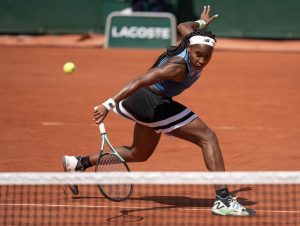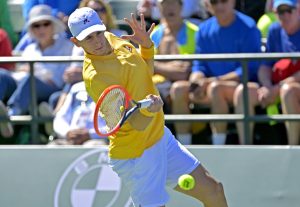Countdown to the US Open: In the fourth and final part of our series building up to the US Open, Last Word on Tennis looks back at the finest US Open Men’s Champions.
Every Grand Slam event is unique. The Australian Open, having been shunned for most of the 20th century by non-Australian players, has reinvented itself as “the Friendly Open”. The French Open and Wimbledon are unique by dint of their surfaces, being the greatest clay court and grass court tournaments respectively. And the US Open is unique by virtue of being played in New York City, the greatest city on Earth. Anyone who can overcome the noise (not just from the fans but from the jets passing overhead), the endless distractions (NYC is one of the great cultural and entertainment capitals of the world) and of course their opponents to win the US Open even once is a genuinely great champion. The players on this list, however, have all done it at least four times, making them the five finest US Open Men’s Champions.
- JOHN McENROE (Winner of four US Opens: 1979, 1980, 1981 and 1984)
There has probably never been a home-town favourite at a Grand Slam event like John McEnroe. McEnroe is a native New Yorker and so had attended the US Open as a fan, even when it was still played on grass (as it was until 1974). He paid particular attention to his all-time hero and idol, “Rocket” Rod Laver, upon whose serve-volleying game he would consciously model his own. As a result, when he appeared at the US Open as a player, McEnroe was singularly well equipped to cope with all the noise and fuss of the Big Apple’s big tennis tournament. In fact, he did not just cope – he thrived, winning a hat-trick of US Opens between 1979 and 1981 and adding one more for good measure in his annus mirabilis of 1984.
McEnroe first broke through as a tennis player when he was an 18-year-old amateur who reached the Wimbledon semi-finals in 1977, where he lost in four sets to the man who would prove his nemesis (yes, even more than Bjorn Borg), Jimmy Connors. It was a spectacular demonstration of both his tennis prowess and his utterly non-conformist attitude to the supposed rules and manners of “tennis etiquette”. It was at Wimbledon, of course, that he first gained world fame as a tennis player, not only because of his brilliant play but because of his petulant behaviour.
It was at Wimbledon, of course, that he first gained world fame as a tennis player, not only because of his brilliant play but because of his petulant behaviour. However, for all his antics on the grass of Wimbledon, it was in his home city that McEnroe won his first Major and New York was where he would win most of his Majors (he finished his career with four US Opens to go alongside his three Wimbledon titles). In 1979, he reached the final and beat his fellow American and good friend, Vitas Gerulaitis, but that was only the precursor to the next two years of epic contests that he would enjoy with Bjorn Borg. Borg usually won at Wimbledon while McEnroe generally triumphed in New York, until McEnroe finally beat Borg at Wimbledon in 1981 and followed that up by beating him in the US Open final later that year.
In 1979, McEnroe reached the US Open final and beat his fellow American and good friend, Vitas Gerulaitis, but that was only the precursor to the next two years of epic contests that he would enjoy with Bjorn Borg. Borg won at Wimbledon while McEnroe triumphed in New York, until McEnroe finally beat Borg at Wimbledon in 1981 and followed that up by beating him in the US Open final later that year.
McEnroe had finally thrown off the shackles that Borg had seemed to place around him, but in a way he was too successful in doing so. After his pair of defeats to McEnroe in 1981, Borg retired and McEnroe freely admits to this day that he himself was never quite the same player again, as he had been robbed of a rivalry that he thought would endure for at least another five years.
Nevertheless, McEnroe, after losing to Connors in the 1982 Wimbledon final (when he still appeared shell-shocked by the absence of Borg on the other side of the net), recovered sufficiently to win Wimbledon again in 1983. That prepared the way for his fantastic 1984, which was the opposite of George Orwell’s nightmarish predictions for that year. Having narrowly lost the French Open to Ivan Lendl, when for two sets he had played probably the finest serve-volley tennis ever seen at Roland Garros, he went on to win Wimbledon for a third time (decimating Connors in the final, for the loss of just four games), before winning the US Open for a fourth time, avenging his Paris loss by beating Lendl in the final (for the loss of just eight games).
And then, like all great magicians, he was gone. He continued to play for a while, even reaching the 1985 US Open final where he lost to Lendl, before a combustible marriage to Tatum O’Neal (another prodigious talent who was almost the female equivalent of McEnroe in the world of acting) led to his taking time off the tour, and when he returned he was never the same player again, to the extent that he never made another Grand Slam final.
McEnroe, of course, has brilliantly reinvented himself as a commentator on tennis and has led the plaudits for the current era of Federer, Nadal and Djokovic. However, even his eulogies to the three great players of the 21st century have been tinged with regret, and recognition that he was probably as naturally talented as all of them, but lacked the willpower to remain injury-free and, even more importantly, distraction-free, which has allowed them to play at the top level into their thirties. He must wonder how many more Majors, including US Opens, he would have won if Borg had continued playing and continued stoking the rivalry that propelled him to play the greatest tennis ever seen before Federer, Nadal and Djokovic began their domination of the game.
JOINT SECOND: JIMMY CONNORS (Winner of Five US Opens: 1974, 1976, 1978, 1982 and 1983)
To say the least, it must irk John McEnroe that Jimmy Connors, his great American rival, won one more US Open than he did, just as it must annoy the hell out of Connors that McEnroe won one more Wimbledon than he did. Theirs appears to be a genuine rivalry, one that continues to this day, with both men still reluctant to discuss their relationship in anything other than the most perfunctory manner.
And yet, as is the way with most sporting rivalries (indeed, most rivalries of any kind), they were so alike. Both men effectively ushered in the post-1968 professional era in tennis, when the sport was transformed from a game played on genteel grass lawns by genteel people to the ultra-athletic, ultra-competitive sport that it is today. Their style of play may have differed – McEnroe was the great serve-volleyer, while Connors was an indefatigable baseliner – but in their sheer will to win, which often spilled over into outbursts against officials or even each other, they could have been twins.
Connors won his first US Open in 1974, which was his own annus mirabilis, as he also won both Wimbledon and the Australian Open that year. His victim (no other word will do) in both the Wimbledon and US Open finals was Ken Rosewall, the legendary Australian player who at the time was approaching his 40th birthday. Rosewall’s annihilation by Connors in both those finals was the closest that tennis has ever come to being a blood sport, and aptly symbolised the end of one generation of players (those, like Rosewall, whose career had begun in the amateur era and ended in the Open era) and the beginning of another (those, like Connors, who seemed to be hard-nosed professionals from birth).
Connors never quite repeated his feats of 1974, when he was undoubtedly the best male tennis player in the world, but he continued to be a contender at Grand Slam events for the next decade and beyond, and that was especially true at the US Open. He may not have been a native New Yorker like McEnroe, but he became the classic adopted New Yorker as he won the tournament four more times, including twice in succession in 1982 and 1983, beating Ivan Lendl in the final on both occasions.
The final chapter of Connors’ glorious and storied career at the US Open came in 1991, when he reached the semi-finals before losing to Jim Courier (a case of Little Jim beating Big Jimmy). He was 39 at the time, the same age that Ken Rosewall had been in 1974 when Connors had virtually eviscerated both at Wimbledon and in New York, and in a sense his career had come full circle: he was now the gnarled, wizened veteran being beaten by the young upstart. Courier defeated him in straight sets, but it was nothing like Connors’ own destruction of Rosewall nearly 20 years earlier. Connors was too great a player, and above all too great a competitor, for that ever to have happened, and to this day if someone was creating the perfect tennis player they would look no further than Jimmy Connors for the fighting spirit that all true champions have and need.
JOINT SECOND: PETE SAMPRAS (Winner of five US Opens: 1990, 1993, 1995, 1996, 2002)
My great tennis buddy is a man called Paul Haviland, who is often kind enough to inform me of any errors or omissions that I have made in a piece. We have a shared obsession with tennis, rightly (we believe) regarding it as the greatest individual sport and perhaps even the greatest sport of all. Where we differ is in the individual object of our adoration, with Paul being a proud “Pistol Pete” man and my being a self-declared “Fed-Head”. It is fitting, therefore, that both these great players are joint second, with Jimmy Connors, on this list, because they are both undoubtedly among the finest US Open champions ever.
Notwithstanding his domination of Wimbledon for nearly an entire decade, the Pete Sampras story can largely be told by telling his US Open story. He first won the tournament as a 19-year-old, defeating Andre Agassi, who at the time was far more heralded than he was. He then struggled for a couple of years, enduring inevitable growing pains, both physically and as a tennis player, before triumphantly re-emerging in 1993 when he won both Wimbledon and the US Open.
Wimbledon was the tournament that Sampras would virtually annexe as his own personal possession, winning six out of the next seven editions of the tournament. Such was his domination on grass, with the perfect serve-volley game (to be more precise, the perfect second serve-volley game), that he almost made the greatest tennis tournament in the world boring, because nobody else could get near him, let alone defeat him.
By contrast, he did not enjoy total domination in the US Open. He won two more titles in 1995 and 1996 (beating Agassi, again, and Michael Chang respectively in the final), but incredibly it was to be another six years before he won his final US Open and what would turn out to be his final Major of any kind.
Such is the legend of Sampras (John McEnroe, for one, regards him as one of the five greatest players ever, alongside Laver, Federer, Nadal and Djokovic) that it is easy to forget that the end of his celebrated career was not the ceremonial procession that it might now appear. His late career troubles really began in the 2000 US Open final, when he was blasted off court by the young Marat Safin. Even more astoundingly, he finally lost his iron grip on the Wimbledon title the following summer, when he was beaten by the man who would eventually break his record of seven Wimbledon titles, Roger Federer. When he lost again in the 2001 US Open final, to Lleyton Hewitt, and then suffered an embarrassing loss at Wimbledon in 2002 to George Bastl, a far less prominent Swiss than Federer, it seemed that the game, and indeed the great career, was up.
That is what makes his final US Open win so extraordinary. This year, we have become accustomed to “late period greatness” by tennis players, with Federer and Nadal both seemingly turning back time to win Grand Slam events for the first time in five and three years respectively. But in 2002, it seemed incredibly unlikely that Sampras would ever win a Major again. That he did so, once again beating Agassi in the final, and then retired immediately afterwards, made it a “late play” comparable to Shakespeare’s The Tempest or David Bowie’s Blackstar. In that instance, the man who had once won so easily achieved a feat so extraordinarily difficult that he won over any last doubters, including me.
JOINT SECOND: ROGER FEDERER (Winner of five US Opens: 2004, 2005, 2006, 2007 and 2008)
So much has been said about Federer this year, when he has defied time to win two Grand Slam events (Australia and Wimbledon) for the first time in nearly a decade, that I will say only this for now. If he somehow manages to win the US Open again this year (and with injury doubts surrounding Andy Murray and Novak Djokovic he will probably start the tournament as favourite), he will do so for the sixth time, making him a clear second on this list of all-time great US Open champions. In the process, he will also strengthen the arguments of many (myself included) that he is undoubtedly the finest male player of all time. Although Rafael Nadal has often been Federer’s nemesis and enjoys an overall winning head-to-head record against him, the fact is that the vast majority of Nadal’s Majors (10 out of the 15, or nearly 70% of them) have been won on just one surface, namely the clay of Paris. By contrast, Federer will be able to produce eight Wimbledon titles, six US Open titles, five Australian titles and even one French title to prove that he is, without doubt, the greatest all-round player and the greatest attacking player of all time.
Of course, if Nadal wins a third US Open, which is eminently possible, it will be another story entirely…
1ST: BILL TILDEN (Winner of seven US Opens: 1920, 1921, 1922, 1923, 1924, 1925 and 1929)
Bill Tilden is not the only man to have won seven US titles (or US Championships, as they were called before the Open era began in 1968). In fact, two other men – William Larned and Richard Sears, who were also both American – have also won seven titles. However, all 14 of their US titles were won before the First World War; indeed, all seven of Sears’s titles were won before the start of the 20th century, as he won the first seven instalments of the US Open from 1881 on. At that time, competition was far less intense than it would become later, with Sears being granted automatic qualification for the following year’s final each time he won the tournament. Thus, Tilden stands apart from the other “seven-timers”, simply because his seven titles were won in a far more competitive era.
Tilden was known as “Big Bill”, as he was over six feet tall, which is short for a tennis player in the 21st century but was considered gargantuan a hundred years ago. Like Suzanne Lenglen on the other side of the Atlantic, he emerged after World War One as the dominant player of his gender, winning six US titles in a row between 1920 and 1925. The last of those finals, against “Little” Bill Johnston, was particularly memorable and is arguably the greatest ever men’s US Open final.
Having won one more US title in 1929, Tilden finally turned professional in 1931 and so ended his Major-playing career. Remarkably he continued to play professionally until 1946, when he was 53 years old, and was still considered to be a fine player at that venerable age. Even Roger Federer, who professed after winning this year’s Wimbledon that he would like to play for a few more years yet, would do well to match that level of longevity.
As with all the great tennis players of the past (especially those who played before WW2), so little footage survives of Tilden that it is difficult, if not impossible, to make a definitive assessment of his playing ability and say how he would compare with more recent stars, such as the other players on this list. But his contemporaries were in no doubt as to his greatness, so much so that he was considered one of the “Six Great Figures of Sport” in America in the 1920s, alongside such luminaries as golfer Bobby Jones and baseball’s greatest, Babe Ruth.
Tilden finally stopped playing tennis not because he wanted to but because he was effectively forced to. In 1946, he was arrested and imprisoned for under-age sex with a boy of 14. Homosexuality was illegal in the US at the time, as it was in almost every other country, and so Tilden was ruined, losing much of the fame and fortune that he had generated through his stellar tennis career. Even though homosexuality was later legalised in the US, as in most Western countries, the “stain” on Tilden’s name was such that it might explain his relative lack of fame today.
The story of Tilden’s rise to fame, subsequent disgrace and possible future rehabilitation is worthy of a movie, one to rival the similar story told about Alan Turing in The Imitation Game. If Tilden cannot quite claim to have contributed to the early ending of World War Two, as Turing could after breaking the Nazis’ Enigma code, he can certainly claim to be the greatest male tennis player, indeed the greatest male sportsman, who is largely forgotten today. His story deserves retelling, to show how a truly great man was destroyed by laws that have subsequently been overturned. It is true that the boy Tilden was arrested for seducing was under-age, but in the twilight world of post-war homosexuality it must have been difficult, if not impossible, to adequately assess the age or degree of consent of many sexual partners. Big Bill deserves far better than to be forgotten and in the future his remarkable story can hopefully be told fully for the first time.
Enjoy articles looking back at all-time best players and tennis history in general? Make sure to check out our page devoted to stories appreciating historic achievements in tennis.






